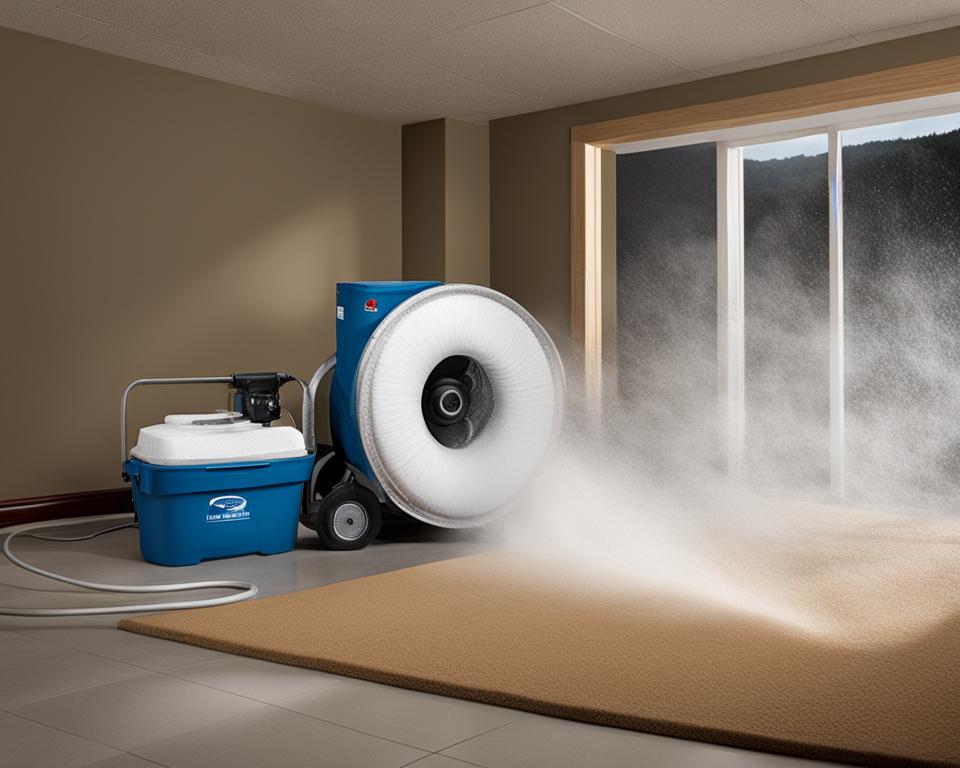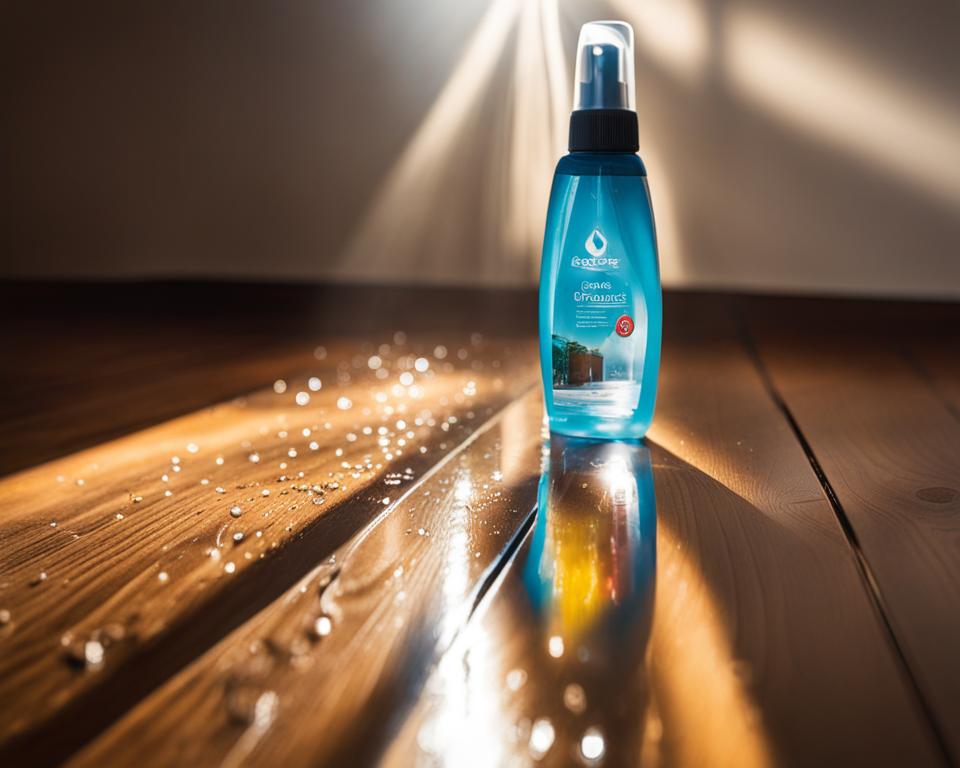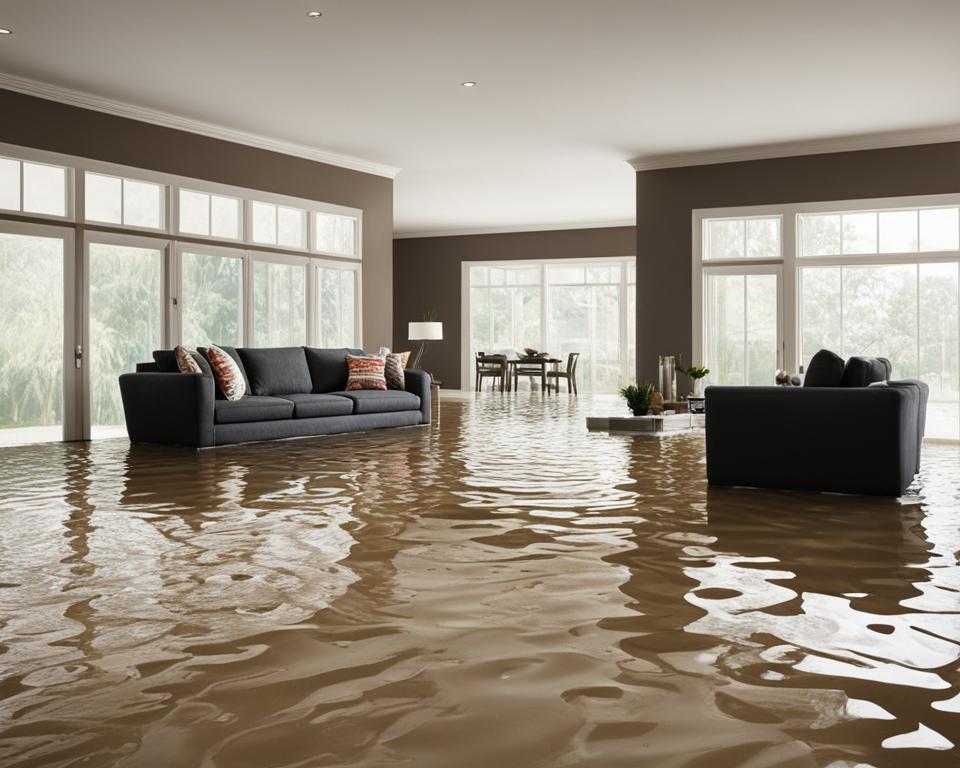When your home experiences water damage, it is crucial to take immediate action to save and salvage your carpets and flooring. Water damage can occur from various sources, including broken pipes, flooded bathrooms, malfunctioning appliances, or natural factors like melting snow or excessive rain. Water damage can be particularly detrimental to carpets, as it is not as simple as wiping up a spill. Mold and mildew can start growing within 12 hours of water damage, making fast response essential. In this section, we will discuss the best practices for treating water-damaged carpets, including drying the carpet quickly, drying the padding, deodorizing the carpets, and sanitizing the floors. We will also provide information on finding professional water damage restoration services to ensure proper and thorough restoration of your carpets and flooring.
Key Takeaways:
- Act immediately to save and salvage your water-damaged carpets and flooring.
- Mold and mildew can start growing within 12 hours, so quick response is crucial.
- Dry the carpets and flooring quickly to prevent further damage and mold growth.
- Consider professional water damage restoration services for comprehensive restoration.
- Sanitize the floors, especially if the water is contaminated.
How to Dry Wet Carpets Quickly
When your carpet suffers water damage, it is crucial to dry it quickly to prevent mold and mildew growth. Use towels to soak up small spills, but for larger water damage, open windows, turn on fans, or use a blow dryer to speed up the drying process. Dehumidifiers can also be helpful in reducing moisture levels.
If you are dealing with significant water damage, consider renting a wet-dry vacuum or contacting professionals for assistance. Quick and effective drying is essential to prevent further damage and ensure the longevity of your carpets.
| Drying Methods | Benefits |
|---|---|
| Using towels to soak up small spills | – Immediate action to minimize moisture |
| Opening windows and turning on fans | – Facilitates air circulation and speeds up drying |
| Using a blow dryer | – Directs heat to evaporate moisture |
| Utilizing dehumidifiers | – Reduces humidity levels in the room |
| Renting a wet-dry vacuum | – Extracts excess water efficiently |
Drying the Padding
In some cases of water damage, it may be necessary to lift the carpet to dry the padding beneath it. This step is crucial to prevent mold and mildew growth and ensure the complete restoration of your carpets. Use the same drying methods mentioned in Section 2 to dry the padding effectively. If you are unsure how to lift the carpet, there are instructional videos available online. Taking the necessary steps to dry the padding will contribute to the overall success of restoring your water-damaged carpets.

Once you have addressed the water damage to your carpets, it’s important to focus on drying the padding underneath. The padding is an essential component of your carpet’s structure, and failure to dry it thoroughly can lead to long-term issues such as mold and mildew growth.
The process of drying the padding involves lifting the carpet to expose the affected area. This may seem like a daunting task, but it is necessary for effective restoration. If you are unsure how to lift the carpet, there are instructional videos available online that can guide you through the process step-by-step.
Once the carpet is lifted, you can use the same drying methods mentioned in Section 2 to dry the padding effectively. This may include using fans, opening windows, or renting a wet-dry vacuum to extract excess moisture. The goal is to create airflow and remove as much moisture as possible to prevent the growth of mold and mildew.
It’s important to note that the drying process may take longer for the padding compared to the surface of the carpet. This is because the padding is more absorbent and may retain moisture for a longer period of time. Be patient and thorough in your drying efforts to ensure the best possible outcome.
| Steps for Drying the Padding |
|---|
| 1. Lift the carpet to expose the affected area. |
| 2. Create airflow by using fans or opening windows. |
| 3. Rent a wet-dry vacuum to extract excess moisture. |
| 4. Allow sufficient time for the padding to dry completely. |
By taking the necessary steps to dry the padding, you can minimize the risk of mold and mildew growth, and ensure the complete restoration of your water-damaged carpets. Remember, if the task feels overwhelming or if the water damage is extensive, it is always wise to seek professional water damage restoration services.
Deodorizing the Carpets
Water-damaged materials can develop a musty smell if left unattended. To deodorize your carpets, follow these steps:
- Dry the carpets as best as you can using fans or wet-dry vacuums. The faster you can dry them, the better.
- When the carpets are slightly damp, use a live-enzyme cleaner or a mixture of hydrogen peroxide and water to thoroughly clean the area. These solutions are effective at neutralizing odors.
- Sprinkle baking soda on the carpet and let it sit for a few minutes. Baking soda is known for its odor-absorbing properties.
- After letting the baking soda sit, vacuum it up. This step helps remove any remaining dirt or odor particles.
- If persistent odors persist, blot the affected area with white vinegar. Vinegar is great at absorbing odors and can help eliminate any lingering smells.
Proper deodorization is essential for restoring the freshness and quality of your water-damaged carpets.
| Step | Deodorizing Process |
|---|---|
| 1 | Dry carpets using fans or wet-dry vacuums. |
| 2 | Clean the area with a live-enzyme cleaner or a mixture of hydrogen peroxide and water. |
| 3 | Apply baking soda on the carpet and let it sit. |
| 4 | Vacuum the area to remove baking soda and dirt. |
| 5 | If needed, blot the area with white vinegar to eliminate persistent odors. |
Sanitizing Your Floors
Depending on the type of water that caused the damage, sanitization may be necessary. If the water is contaminated, such as toilet water, it is crucial to sanitize the affected areas for peace of mind. Sanitizing your floors after water damage ensures the removal of bacteria and pathogens, making your living environment safe and clean.
Steam-Cleaning for Effective Sanitization
Steam-cleaning is a highly effective method for sanitizing water-damaged floors, including both the carpet and the padding beneath. By using high-temperature steam, this technique eliminates harmful bacteria and germs, ensuring thorough sanitization. For optimal results, you can rent steam-cleaning machines from retail stores or hire professionals experienced in water damage restoration services.
Sanitizing Walls and Baseboards
In cases of extensive water damage, it is important to consider sanitizing not only the floors but also the surrounding walls and baseboards. Water can seep into these surfaces, causing potential contamination and mold growth. By applying appropriate sanitization measures, such as wiping down the walls and baseboards with antimicrobial solutions, you can ensure the complete restoration of your space.
| Steps for Sanitizing Your Floors: |
|---|
| 1. Assess the water contamination level: Determine if the water damage is from clean water, gray water (containing some contaminants), or black water (contaminated with sewage or chemicals). |
| 2. Extract excess water: Remove any standing water or excessive moisture from the affected area to minimize the risk of further damage and mold growth. |
| 3. Hire professionals or rent steam-cleaning equipment: Steam-clean your carpets and flooring to eliminate bacteria and pathogens. Consider enlisting the help of professionals experienced in water restoration services or renting steam-cleaning equipment from retail stores. |
| 4. Sanitize walls and baseboards: Clean and sanitize surrounding walls and baseboards to prevent the spread of contaminants and potential mold growth. |
| 5. Inspect for any remaining damage: Once sanitization is complete, thoroughly inspect the floors for any signs of damage or lingering issues. Address any concerns immediately to ensure a complete restoration. |

By following these steps and utilizing appropriate sanitization methods, you can effectively restore the cleanliness and safety of your floors after water damage. Remember, in instances of severe water damage, it is recommended to seek professional water damage restoration services to ensure the best possible results.
Seeking Professional Water Damage Restoration Services
When faced with water-damaged carpets and flooring, it is crucial to understand that restoring them requires a complex and time-sensitive process. If you find the restoration process overwhelming or if the damage is extensive, seeking professional water damage restoration services is highly recommended. These professionals possess the necessary knowledge, expertise, and specialized equipment to effectively remove water, dry carpets and flooring, prevent mold growth, and restore the affected areas to their original condition.
One reputable company offering comprehensive water damage restoration services is Elite Restoration. Their team of trained professionals understands the urgency of emergency water damage situations and responds promptly to provide immediate assistance. With their expertise, state-of-the-art equipment, and meticulous attention to detail, Elite Restoration ensures that the restoration process is done right, preventing further damage or mold growth.
By contacting professional water damage restoration services, you can have peace of mind knowing that your carpets and flooring are in capable hands. The specialists at Elite Restoration will assess the extent of the damage, develop a customized restoration plan, and work diligently to restore your property to its pre-damaged state. Don’t take chances with DIY methods when it comes to water damage restoration; trust the professionals to provide efficient and effective solutions for your emergency water damage needs.
FAQ
How quickly should I dry my carpets after water damage?
It is crucial to dry your carpets quickly to prevent mold and mildew growth. Within 12 hours of water damage, mold and mildew can start growing. Soak up small spills with towels and use fans, open windows, or a blow dryer to speed up the drying process. Consider renting a wet-dry vacuum or contacting professionals for larger water damage.
Should I lift the carpet to dry the padding?
In some cases of water damage, lifting the carpet to dry the padding is necessary to prevent mold and mildew growth and ensure complete restoration. Use the same drying methods mentioned in section 2 to effectively dry the padding. Instructional videos are available online to assist with lifting the carpet.
How can I deodorize water-damaged carpets?
To deodorize your carpets, dry them using fans or wet-dry vacuums. When the carpets are slightly damp, clean the area with a live-enzyme cleaner or a mixture of hydrogen peroxide and water. Sprinkle baking soda on the carpet, let it sit for a few minutes, and then vacuum it up. For persistent odors, blot the area with white vinegar.
Is sanitization necessary after water damage?
Depending on the type of water that caused the damage, sanitization may be necessary. If the water is contaminated, such as toilet water, it is crucial to sanitize the affected areas for peace of mind. Steam-cleaning is an effective way to sanitize both the padding and carpet. Consider sanitizing the surrounding walls and baseboards as well.
Should I seek professional water damage restoration services?
If you find the restoration process overwhelming or if the damage is extensive, it is highly recommended to seek professional water damage restoration services. Professionals have the knowledge, experience, and specialized equipment to effectively remove water, dry carpets and flooring, prevent mold growth, and restore the affected areas to their original condition.

Leave a Reply